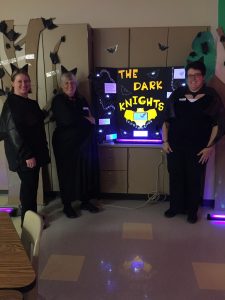
Adams County FSA employees transformed into bats for an educational conservation presentation to sixth grade students in Adams County schools.
Bats – The Real Dark Knights
By: Abigail Armentrout, Indiana Farm Service Agency, County Operations Trainee
Splash! It is a common sound this time of year as the weather gets warmer and kids start playing in the water. However, for Sandy Voglewede and the Adams County FSA, Indiana Soil and Water Conservation District (SWCD), SPLASH stands for Soil, PeopLe, Air, animalS and H2O.
The SPLASH event is one of the highlights of the school year in Adams County, Indiana. This year marked the 21st annual event held by the SWCD for sixth grade students in Adams County schools. The event included presentations from the SWCD, Farm Service Agency (FSA), the Natural Resources Conservation Service (NRCS), Indiana State Department of Agriculture, Adams County Forestry, Purdue Extension and conservation officers from the Department of Natural Resources.
The presentations covered a wide range of topics including livestock, Global Positioning System demonstrations, watersheds, forestry, water and All Terrain Vehicle safety. Katrina Wangler, Adams County FSA County Executive Director (CED), and Jennifer Bolinger and Abigail Armentrout, county operations trainees (COTs), represented FSA and gave a presentation on conservation for bat populations incorporating this year’s theme, “We All Need Trees.”
Their interactive presentation, “The Real Dark Knights,” focused on educating students about bats and their needs, while dispelling some of the myths about bats and their behavior. For example, bats are not blind; rather, bats rely more on their hearing and echolocation, rather than their sight, to catch the hundreds of insects they eat in a single hour.
Additionally, part of the reason bats are attracted to living in attics and barns is due to the destruction of their natural habitats – trees. FSA has tree practices in the Conservation Reserve Program (CRP) that focus on maintaining habitats for the Indiana Brown Bat, a protected species.
CRP is a voluntary program that contracts with agricultural producers so that environmentally sensitive agricultural land is not farmed or ranched, but instead used for conservation benefits. CRP participants establish long-term, resource-conserving plant species, such as approved grasses or trees (known as “covers”) to control soil erosion, improve water quality and develop wildlife habitat. In return, FSA provides participants with rental payments and cost-share assistance. Contract duration is between 10 and 15 years.
Preparing for the SPLASH presentation meant weeks of research and preparation. FSA employees created displays of large cardboard trees with origami bats hung from them and a black display board that lit up to look like bats’ eyes in the dark. The team presented wearing bat costumes in order to provide a more engaging experience for the students. They also quizzed the students to check and guide their understanding of bats and how important they are to their ecosystem.
FSA has been a part of SPLASH for several years and looks forward to continue educating youth on conservation issues and practices in the years to come.
To learn more about the FSA CRP program, visit www.fsa.usda.gov/crp.






One Response to Adams County FSA Educates Children about Conservation and Bats in Indiana